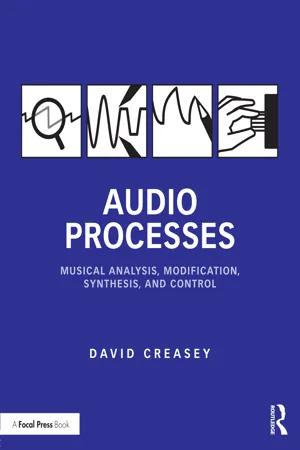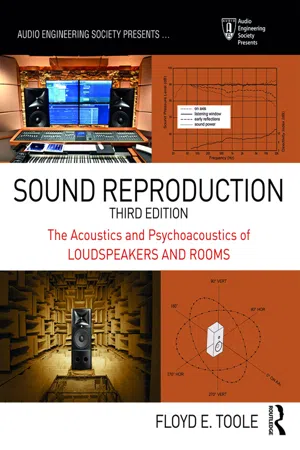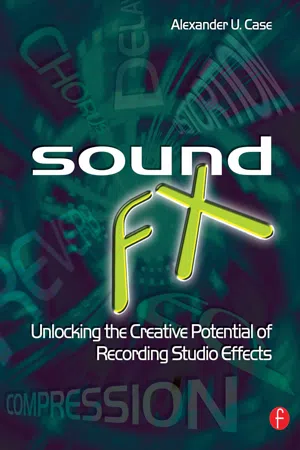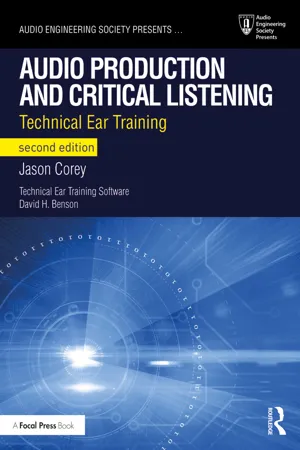Physics
Distortion
Distortion refers to the alteration or deformation of an object or signal from its original form. In physics, distortion can occur in various forms, such as in the transmission of waves or in the behavior of materials under stress. Understanding and mitigating distortion is important in fields like acoustics, optics, and material science.
Written by Perlego with AI-assistance
Related key terms
Related key terms
1 of 4
Related key terms
1 of 3
5 Key excerpts on "Distortion"
- eBook - ePub
Audio Processes
Musical Analysis, Modification, Synthesis, and Control
- David Creasey(Author)
- 2016(Publication Date)
- Routledge(Publisher)
7 Distortion7.1 Introduction 7.1.1 Avoiding and Creating Distortion 7.1.2 Hard Clipping 7.2 Distortion Functions 7.2.1 Soft Clipping Distortion 7.2.2 Other Distortion Transfer Functions 7.2.3 Controlling Distortion Character 7.3 Distortion of Complex Signals 7.4 Developing Processes and Learning More 7.1 Introduction
7.1.1 Avoiding and Creating Distortion
Distortion is defined as the deformation of a signal in some way as it passes through a system. Most electronic and computer systems attempt to avoid this such that the signal character is preserved. For example, a video system will usually attempt to create a visual output that matches the original input as accurately as possible. In such cases increased quality involves minimising Distortion.For musical applications the desirability of Distortion depends on context. When recording classical music, microphones and preamplifiers will be chosen that have the most transparent and accurate character. However, an electric guitar amplifier might deliberately distort the signal for use in rock music. There are a wide range of analogue circuits and systems whose results include some amount of Distortion, such as:- Amplifiers.
- Loudspeakers.
- Communication links (such as analogue telephone lines, AM radio, submarine communications).
- Magnetic tape audio recorders.
Distortions such as those in the above circuits can be musically useful. Simulating them in digital form is convenient, and avoids the dangers of damaging equipment when used at the limits of operation.It is very difficult to objectively measure whether a particular type of Distortion is of higher or lower quality than another, as it depends on the desired musical results. One of the most common types of Distortion is that associated with non-linear amplification, - eBook - ePub
Sound Reproduction
The Acoustics and Psychoacoustics of Loudspeakers and Rooms
- Floyd Toole(Author)
- 2017(Publication Date)
- Routledge(Publisher)
Section 5.3 ), which normally is sufficient to describe sound quality, was not rated highly as expected. The problem was found to be intermodulation Distortion, an extremely rare event, associated with the way sounds from a woofer and tweeter combined in a concentric arrangement—so constant vigilance and listening are essential.Taking advantage of advances in psychoacoustic understanding, and utilizing the analytical and modeling capabilities of computers, some new investigations are attempting to identify some of the underlying perceptual mechanisms, and develop better test methods. Cabot (1984) provides a good historical perspective; Voishvillo (2006, 2007) provides an excellent overview of the past, present and possible future of Distortion measurements. Geddes and Lee (2003), Lee and Geddes (2003, 2006), Moore et al. (2004), and Temme and Dennis (2016) provide additional useful perspectives.In loudspeakers it is fortunate that Distortion is something that normally does not become obvious until devices are driven close to or into some limiting condition. In large-venue professional devices, this is a situation that can occur frequently. In the general population of consumer loudspeakers, it has been very rare for Distortion to be identified as a factor in the overall subjective ratings. This is not because Distortion is not there, or not measurable, but it is low enough that it is not an obvious factor in judgments of sound quality at normal listening levels.4.10 Wavelength, the Key to Understanding Much in Audio
In audio most discussions involve frequency, and events in the frequency domain. But to understand why many of these things happen, it is essential to understand the concept of wavelength. The explanation begins with the speed of sound, which, at sea level and normal room temperature (72°F/22°C), is: - eBook - ePub
- Jerry C. Whitaker, Jerry C. Whitaker, Richard C. Dorf, Jerry C. Whitaker(Authors)
- 2017(Publication Date)
- CRC Press(Publisher)
22Radio Frequency Distortion Mechanisms and Analysis
Samuel O. AgboCalifornia Polytechnic State University , San Luis Obispo22.1 Introduction 22.2 Types of Distortion Linear Distortion Nonlinear Distortion Distortion Due to Time-Variant Multipath Channels 22.3 The Wireless Radio Channel Ground Waves Tropospheric Waves Sky Waves 22.4 Effects of Phase and Frequency Errors in Coherent Demodulation of AM Signals Double-Sideband Suppressed-Carrier (DSB-SC) Demodulation Errors Single-Sideband Suppressed-Carrier (SSB-SC) Demodulation Errors 22.5 Effects of Linear and Nonlinear Distortion in Demodulation of Angle Modulated Waves Amplitude Modulation Effects of Linear Distortion Effects of Amplitude Non-linearities on Angle Modulated Waves Phase Distortion in Angle Modulation 22.6 Interference as a Radio Frequency Distortion Mechanism Interference in Amplitude Modulation Interference in DSB-SC AM Interference in SSB-SC Interference in Angle Modulation22.1 Introduction
Radio frequency (RF) communication is usually understood to mean radio and television broadcasting, cellular radio communication, point-to-point radio communication, microwave radio, and other wireless radio communication. For such wireless radio communication, the communication channel is the atmosphere or free space. It is in this sense that RF Distortion is treated in this section, although RF signals are also transmitted through other media such as coaxial cables.Distortion refers to the corruption encountered by a signal during transmission or processing that mutilates the signal waveform. A simple model of the atmospheric radio channel, as shown in Fig. 22.1 , will help to illustrate the sources of radio frequency Distortion. The channel is modeled as a linear time-variant system with additive noise and additive interference. In the figure, s (t ) is the RF signal to be transmitted through the channel, h (t, τ ) is the channel impulse response, n (t ) is the additive noise, i (t ) is the interference, and r (t - eBook - ePub
Sound FX
Unlocking the Creative Potential of Recording Studio Effects
- Alex Case(Author)
- 2012(Publication Date)
- Routledge(Publisher)
Other types of audio equipment possess some kind of Distortion more as a side effect. Transducers, compressors, tube gain stages, and analog magnetic tape are among the more notable examples. The devices have other design goals. A microphone must convert acoustic pressure changes into electrical voltage changes, a loudspeaker must convert electrical voltage changes back into air pressure changes, a compressor automatically attenuates audio when the signal is above the specified threshold, etc. In addition to this nominal function, many of these devices also introduce harmonic and intermodulation Distortions of varying types which may be taken advantage of by the clever recordist to further refine the sound quality of the audio signal at hand.Musicians think of timbre as that attribute of sound that separates a piano from a guitar when they play the same note. Engineers must sort out what sonically separates a Steinway from a Bösendorfer among pianos and a Les Paul from a Telecaster among guitars, even as these instruments play the same note. Trained and careful listeners can reliably distinguish very fine properties of a sound. The unique Distortion traits of each audio device in the studio endow that device with a sort of sound fingerprint related to Distortion. Distorting devices, like fuzz boxes and tube amps, offer their own characteristic qualities of Distortion. Some mixture of hard clipping, soft clipping, asymmetric, and other forms of Distortion adds up to a distinct and possibly quite desirable sound quality. Any component, pushed beyond its linear limits, offers harmonic and nonharmonic alterations to the signal passing through it that may impart a sonic flavor an engineer seeks.4.3 Motivations for DistortionThis effect is not just for engineers. Distortion of the right kind is naturally sought out by musicians and music fans alike. Spared the pleasure of reading this text, guitarists, singers, and drummers still employ Distortion as a method of musical expression. Fans of many, if not most, styles of popular music react positively to Distortion almost instinctively. When a device is overloaded, something exciting must be happening. Someone is misbehaving. Rules are being bent or broken. Distortion in rock and roll is as natural as salsa in Mexican food. It is the caffeine of music. Or perhaps it is the garlic. Used musically, most people can not resist. Accordingly, audio engineers reach for Distortion as a staple effect. - eBook - ePub
Audio Production and Critical Listening
Technical Ear Training
- Jason Corey(Author)
- 2016(Publication Date)
- Routledge(Publisher)
Most other commonly available utilitarian sound reproduction devices such as intercoms, telephones, two-way radios, and inexpensive headphones have obvious Distortion. For most situations, such as voice communication, as long as the Distortion is low enough to maintain intelligibility, Distortion is not really an issue. The level of Distortion found in inexpensive audio reproduction systems is usually not detectable by an untrained ear. This is part of the reason for the massive success of the MP3 and other perceptually encoded audio formats found on Internet audio—most casual listeners do not perceive the Distortion and loss of quality, yet audio file size is much smaller than their PCM equivalents to allow easy and fast transfer across networks and minimal storage space on a computer drive or portable device.Whether or not Distortion is intentional, we should be able to identify when it is present and either shape it for artistic effect or remove it, according to what is appropriate for a given recording. Next, we will describe four categories of Distortion: hard clipping, soft clipping, quantization error, and perceptual encoder Distortion.Hard Clipping and OverloadFigure 5.3 A sine wave at 1 kHz that has been hard clipped. Note the sharp edges of the waveform that did not exist in the original sine wave.Hard clipping occurs when we apply enough gain to a signal for it to reach the limits of a device’s maximum input or output level. Peak signal levels greater than a device’s maximum allowable signal level are flattened, creating new harmonics that were not present in the original waveform. For example, if a sine wave (Figure 5.1 ) is clipped, the result is a square wave whose time domain waveform now contains sharp edges (Figure 5.3
Index pages curate the most relevant extracts from our library of academic textbooks. They’ve been created using an in-house natural language model (NLM), each adding context and meaning to key research topics.
Explore more topic indexes
Explore more topic indexes
1 of 6
Explore more topic indexes
1 of 4




